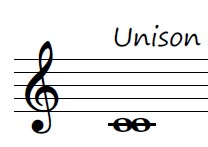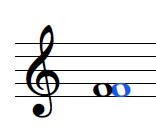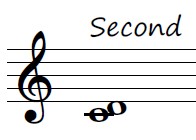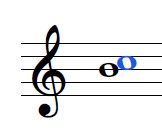Salford Piano Studio
An interval is the distance between two notes.
The first thing to know is that we think of the bottom note as 1, and count up from there.
Let’s take them one at a time.
1st (Unison)
When both notes are the same, it is simply a 1st.
A 1st is also called a Unison, or a Prima.
C and C:

Note: When writing a 1st we place the notes right next to each other.

2nd (Second)
A 2nd is any note and the note above it.
C and D:

A 2nd is also written to the right, for clarity purposes.

3rd (Third)
To illustrate the intervals from 3rd onwards, it’s helpful to use a piano.
A 3rd is made of 1 and 3 (skipping one note in between)
C and E:
4th (Fourth)
A 4th is made of 1 and 4 (skipping two notes in between)
C and F:
5th (Fifth)
A 5th is made of 1 and 5 (skipping three notes in between)
C and G:
6th (Sixth)
A 6th is made of 1 and 6 (skipping four notes in between)
C and A:
7th (Seventh)
A 7th is made of 1 and 7 (skipping five notes in between)
C and B:
8ve (Octave)
An 8ve is made of 1 and 8 (skipping six notes in between)
Note that an Octave will always be the same note only higher. C-C, D-D, E-E etc.
C and C:
Generic Intervals Starting On C
| Interval | Notes |
| 1st | C-C |
| 2nd | C-D |
| 3rd | C-E |
| 4th | C-F |
| 5th | C-G |
| 6th | C-A |
| 7th | C-B |
| 8ve | C-C |